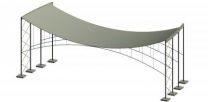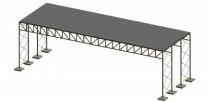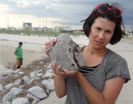(Press-News.org) CORAL GABLES, Fla. (July 14, 2014) -- When envisioning a new structure, engineers often have to balance design choices against the environmental impact of materials used. It is estimated that 40 to 50 percent of greenhouse gases are produced by the construction industry, according to the California Integrated Waste Management Board. Lessening the impact of construction on the environment is a work in progress.
Researchers at the University of Miami (UM) and the University of Milwaukee School of Engineering are searching for designs and materials that are less harmful to the environment. The team compared the sustainability of two structural systems commonly used for spans exceeding 250 feet: the steel cable system and the steel truss system.
"Thoughtful selection, by the architectural engineer, in the initial stages of the design process, can reduce environmental impact related to the construction process," says Matthew Trussoni, assistant professor in practice, at the UM College of Engineering and corresponding author of the study.
The findings show that the selection of steel cable structural system for long spans has considerably less environmental impact than a steel truss system to achieve the same structural requirements, through the entire life cycle of the structure.
Like a spider web, the cable system utilizes tension to sustain a structure. In contrast, the truss system uses compression members in the span of the structure.
"Most structures in nature rely on tension as it is the most efficient way to transfer forces," Trussoni says. "They typically minimize compression members and maximize tension members," he says. "In a tree, for instance, the trunk is the only compression member, and the braches and leaves rely on either a combination of tension and compression, or tension alone, for their support."
For the study, the researchers designed and compared the most efficient configurations for a steel truss and a steel cable structural system. Both systems were intended for the same function and with the same requirements.
To analyze the sustainability of each structure, they used the life-cycle-assessment (LCA), which estimates the environmental impact of a structure during material extraction, manufacturing, construction, use, maintenance and end-of-life phases.
The results show that the cable system has 29 percent less mass, 65.1 percent less embodied energy (the energy required to produce the structural system, including both materials and placement) and generates 67.2 percent less CO2 emissions, than the truss system.
The findings imply that understanding how material selection can affect efficiency is one way to mitigate environmental damage from construction.
The current study titled "Life-Cycle Assessment Comparison for Long-Span Cable and Truss Structural Systems: Case Study" was recently published in in the Journal of Architectural Engineering. Other authors are Evan Simatic, Christopher H. Raebel and H. Peter Huttelmaier, from the Milwaukee School of Engineering.
The researchers are continuing to investigate and compare environmental impacts of other structural systems that can serve the same purpose.
INFORMATION:
The University of Miami's mission is to educate and nurture students, to create knowledge, and to provide service to our community and beyond. Committed to excellence and proud of our diversity of our University family, we strive to develop future leaders of our nation and the world.
Efficient structures help build a sustainable future
Researchers find find that using steel cable structural systems is better for the environment than using structural steel truss systems for long-span structures
2014-07-16
ELSE PRESS RELEASES FROM THIS DATE:
A natural way to monitor, and possibly control populations of, stink bugs
2014-07-16
Anyone who has squashed a stink bug knows why they got their name. Although just a nuisance to homeowners, the insects feed on and damage fruits and vegetables, causing significant economic losses for farmers. Now scientists report in ACS' Journal of Natural Products that they've discovered certain stink bug pheromone components and made them artificially in the lab for the first time, and these substances can be used to monitor and manage their populations.
Ashot Khrimian and colleagues explain that the brown marmorated stink bug, also known as Halyomorpha halys, is ...
Abdominal aortic aneurysms: Mayo Clinic surgeon explains who needs screening, treatment
2014-07-16
Rochester, Minn. — An abdominal aortic aneurysm is a potentially life-threatening condition: If the body's major blood vessel ruptures, it can prove deadly. The U.S. Preventive Services Task Force recently updated its recommendations on screening. Mayo Clinic vascular surgeon Peter Gloviczki, M.D., explains who should be watched for abdominal aortic aneurysms, how they are diagnosed and how surgery, which now includes a less invasive endovascular option, is improving survival rates:
MULTIMEDIA ALERT: Video and audio are available for download on the Mayo Clinic News Network.
What ...
ORNL, UTGSM study compares structures of Huntington's disease protein
2014-07-16
OAK RIDGE, Tenn., July 16, 2014 -- Neutron scattering research at the Department of Energy's Oak Ridge National Laboratory has revealed clear structural differences in the normal and pathological forms of a protein involved in Huntington's disease.
Huntington's disease, an incurable neurodegenerative disorder, starts as a genetic mutation that leads to an overabundance of "huntingtin" protein fragments, which form clumps in the brain.
Valerie Berthelier of the University of Tennessee Graduate School of Medicine, who co-led the study published in Biophysical Journal ...
Expert guidance on hand hygiene in healthcare settings
2014-07-16
CHICAGO (July 16, 2014) – Expert guidance released today offers updated evidence reviews and recommendations for hand hygiene in healthcare facilities. The guidance is featured in the August issue of Infection Control and Hospital Epidemiology and emphasizes best practices for implementing and optimizing hand hygiene programs to prevent the spread of healthcare-associated infections (HAIs). The guidance is part of the Compendium of Strategies to Prevent Healthcare-Associated Infections in Acute Care Hospitals: 2014 Updates produced in a collaborative effort led by the Society ...
Drug's effect on Alzheimer's may depend on severity of disease
2014-07-16
A cancer drug that has shown promise against Alzheimer's disease in mice and has begun early clinical trials has yielded perplexing results in a novel mouse model of AD that mimics the genetics and pathology of the human disease more closely than any other animal model.
The drug, bexarotene, was found to reduce levels of the neurotoxic protein amyloid-beta in experimental mice with late-stage Alzheimer's but to increase levels during early stages of disease.
The finding, by researchers at the University of Illinois at Chicago College of Medicine, was reported July 16 ...
Research connects pregnancy loss and cardiovascular disease
2014-07-16
The Annals of Family Medicine today published an article detailing research showing that women with a history of pregnancy loss are at higher risk for cardiovascular disease later in adulthood than other women, work completed by physicians in the Center for Primary Care and Prevention (CPCP) at Memorial Hospital of Rhode Island.
The article "Risk of Cardiovascular Disease Among Postmenopausal Women with Prior Pregnancy Loss: The Women's Health Initiative" stems from the analysis of data from the maternity experiences of a sample of 77,701 women, according to Donna Parker, ...
Dispersant from Deepwater Horizon spill found to persist in the environment
2014-07-16
The 2010 Deepwater Horizon (DWH) spill in the Gulf of Mexico was the largest accidental release of oil into the ocean, with approximately 210 million gallons gushing from the blown out well. In an attempt to prevent vast quantities of oil from fouling beaches and marshes, BP applied 1.84 million gallons of chemical dispersant to oil to oil released in the subsurface and to oil slicks at the sea surface. The dispersant was thought to rapidly degrade in the environment.
A new study by scientists at Haverford College and Woods Hole Oceanographic Institution (WHOI) has found ...
Researchers develop EHR algorithms to identify undiagnosed hypertension
2014-07-16
CHICAGO – A new study authored by Northwestern Medicine® researchers found that reviewing electronic health records (EHRs) using algorithms can successfully identify patients with previously undiagnosed hypertension, or high blood pressure, with a high rate of accuracy. Of the 1,033 patients that were identified with the EHR algorithms and evaluated, 361 were formally diagnosed with the hypertension and 290 others were diagnosed with related blood pressure conditions such as prehypertension, white-coat hypertension or elevated blood pressure. The study, "A Technology-Based ...
Worm study provides hope for deadly disease of the brain
2014-07-16
LIVERPOOL, UK – 17 July 2014: An untreatable and deadly neurodegenerative disease has been modelled and treated in worms by University of Liverpool researchers, suggesting a cure could be found for humans.
The scientists studied adult onset neuronal lipofuscinosis (ANCL) which usually strikes around 1 in 100,000 people in Europe and North America in their 30s and results in death by the mid-40s. There is currently no known treatment for this disease, though it has recently been identified as being caused by mutations in the gene called DNAJC5.
For the first time scientists, ...
Cholesterol-lowering drugs may reduce cardiovascular death in Type 2 diabetes
2014-07-16
WINSTON-SALEM, N.C. – July 16, 2014 – Heart disease and stroke are the leading causes of death and disability among people with Type 2 diabetes. In fact, at least 65 percent of people with diabetes die from some form of heart disease or stroke, according to the American Heart Association.
However, a new study by researchers at Wake Forest Baptist Medical Center suggests that the use of cholesterol-lowering statins may help prolong the lives of people with diabetic cardiovascular disease.
The study is published in the current online edition of Diabetes Care.
"Although ...
LAST 30 PRESS RELEASES:
Manta rays create mobile ecosystems, study finds
Study: Mixed results in using lipoic acid to treat progressive multiple sclerosis
Norbert Holtkamp appointed director of Fermi National Accelerator Laboratory
New agentic AI platform accelerates advanced optics design
Biologists discover neurons use physical signals — not electricity — to stabilize communication
Researchers discover that a hormone can access the brain by hitchhiking
University of Oklahoma researcher awarded funding to pursue AI-powered material design
Exploring how the visual system recovers following injury
Support for parents with infants at pediatric check-ups leads to better reading and math skills in elementary school
Kids’ behavioral health is a growing share of family health costs
Day & night: Cancer disrupts the brain’s natural rhythm
COVID-19 vaccination significantly reduces risk to pregnant women and baby
The role of vaccination in maternal and perinatal outcomes associated with COVID-19 in pregnancy
Mayo Clinic smartwatch system helps parents shorten and defuse children's severe tantrums early
Behavioral health spending spikes to 40% of all children’s health expenditures, nearly doubling in a decade
Digital cognitive behavioral treatment for generalized anxiety disorder
Expenditures for pediatric behavioral health care over time and estimated family financial burden
Air conditioning in nursing homes and mortality during extreme heat
The Alps to lose a record number of glaciers in the next decade
What makes a good proton conductor?
New science reporting guide published for journalists in Bulgaria
New international study reveals major survival gaps among children with cancer
New science reporting guide published for journalists in Turkey
Scientists develop a smarter mRNA therapy that knows which cells to target
Neuroanatomy-informed brain–machine hybrid intelligence for robust acoustic target detection
Eight SwRI hydrogen projects funded by ENERGYWERX
The Lundquist Institute and its start-up company Vitalex Biosciences Announces Strategic Advancement of Second-Generation fungal Vaccine VXV-01 through Phase 1 Trials under $40 Million Competitive Con
Fine particles in pollution are associated with early signs of autoimmune disease
Review article | Towards a Global Ground-Based Earth Observatory (GGBEO): Leveraging existing systems and networks
Penn and UMich create world’s smallest programmable, autonomous robots
[Press-News.org] Efficient structures help build a sustainable futureResearchers find find that using steel cable structural systems is better for the environment than using structural steel truss systems for long-span structures



